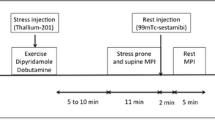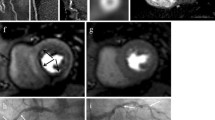Abstract
We describe a case of a 54-year-old male who underwent exercise technetium-99m sestamibi myocardial perfusion imaging prior to his renal transplantation. With exercise, the patient's myocardial perfusion imaging did not show any transient or fixed myocardial perfusion abnormalities due to balanced ischemia. However, wall motion analysis showed a new global left ventricular systolic dysfunction on post-exercise images. Coronary angiography showed severe left main coronary lesion involving ostia of left anterior descending, ramus intermedius and left circumflex coronary arteries with moderate right coronary artery disease. If one had used the perfusion imaging alone in this patient, the severe multivessel disease including left main coronary disease could have been missed. In this article we emphasize the importance of wall motion analysis in patients undergoing myocardial perfusion imaging.
Similar content being viewed by others
References
Sharir T, Germano G, Kavanagh PB, et al. Incremental prognostic value ofpost-stres s left ventricular ejection fraction and volume by gated myocardial perfusion single photon emission computer tomography. Circulation 1999; 100: 1035–1042.
Heyndrickx GR, Millard RW, McRitchie RJ, Maroko PR, Vatner SF. Regional myocardial functional and electrophysiological alterations after brief coronary artery occlusion in conscious dogs. J Clin Invest 1975; 56: 978–985.
Theroux P, Ross J, Franklin D, Kemper WS, Sasyama S. Regional myocardial function in the conscious dog during acute coronary occlusion and responses to morphine, propranolol, nitroglycerin, and lidocaine. Circulation 1976; 53: 302–314.
Matsuzaki M, Gallagher KP, Kemper WS, White F, Ross J. Sustained regional dysfunction produced by prolonged coronary stenosis: gradual recovery after reperfusion. Circulation 1983; 68: 170–182.
Nicklas JM, Becker LC, Bulkley BH. Effects of repeated brief coronary occlusion on regional left ventricular function and dimension in dogs. Am J Cardiol 1985; 56: 473–478.
Robertson WS, Feigenbaum H, Armstrong WF, Dillon JC, O'Donnell J, McHenry PW. Exercise echocardiography: a clinically practical addition in the evaluation of coronary artery disease. J Am Coll Cardiol 1983; 2: 1085–1091.
Homans DC, Laxson DD, Sublett E, Pavek T, Crampton M. Effect ofexercise intensity and duration on regional function during and after exercise-induced ischemia. Circulation 1991; 83: 2029–2037.
Ambrosio G, Betocchi S, Pace L, et al. Prolonged impairment of regional contractile function after resolution of exercise-induced angina: evidence of myocardial stunning in patients with coronary artery disease. Circulation 1996; 94: 2455–2464.
Hashimoto J, Kubo A, Iwasaki R, et al. Gated singlephoton emission tomography imaging protocol to evaluate myocardial stunning after exercise. Eur J Nucl Med 1999; 26: 1541–1546.
Borges-Neto S, Javed A, Shaw LK, et al. Post stress measurements of left ventricular function with gated perfusion SPECT: comparison with resting measurements by using a same-day perfusion-function protocol. Radiology 2000; 215: 529–533.
Shirai N, Yamagishi H, YoshiyamaM, Teragaki M, Akioka K, et al. Incremental value of assessment of regional wall motion for detection of multivessel coronary artery disease in exercise 201Tl gated myocardial perfusion imaging. J Nucl Med 2002; 43: 443–450.
Sharir T, Bacher-Stier C, Dhar S, et al. Identification of severe and extensive coronary artery disease by postexercise regional wall motion abnormalities in Tc-99m sestamibi gated single-photon emission computed tomography. Am J Cardiol 2000; 86: 1171–1175.
de Feyter PJ, Serruys PW. Thrombolysis of acute total occlusion of the left main coronary artery in evolving myocardial infarction. Am J Cardiol 1984; 53: 1727–1728.
Goldberg S, Grossman W, Markis JE, et al. Total occlusion of the left main coronary artery: a clinical hemodynamic and angiographic profile. Am J Med 1978; 64: 3–8.
Ward DE, Valantine H, Hui W. Occluded left main stem coronary: report offive patients and review ofpublished reports. Br Heart J 1983; 49: 276–279.
Yamaji H, Iwasaki K, Kusachi S, et al. Prediction ofacute left main coronary artery obstruction by 12 lead electrocardiography. J Am Coll Cardiol 2001; 38: 1348–1354.
Gorgels AP, Engelen DJ, Wellens HJ. Lead a VR, a mostly ignored but very valuable lead in clinical electrocardiography. J Am Coll Cardiol 2001; 38: 1355–1356.
Engelen DJ, Gorgels AP, Cheriex EC, et al. Value of electrocardiogram in localizing the occlusion site in the left anterior descending coronary artery in acute anterior myocardial infarction. J Am Coll Cardiol 1999; 34: 389–395.
Author information
Authors and Affiliations
Rights and permissions
About this article
Cite this article
Kumar, S.P., Movahed, A. Importance of wall motion analysis in the diagnosis of left main disease using stress nuclear myocardial perfusion imaging. Int J Cardiovasc Imaging 19, 219–224 (2003). https://doi.org/10.1023/A:1023606223940
Issue Date:
DOI: https://doi.org/10.1023/A:1023606223940




